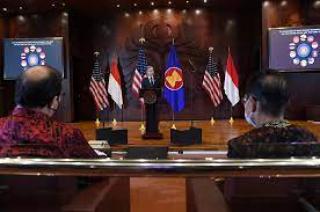One topic in particular loomed large at both gatherings: China.
In Sintra, Portugal, an annual central banker meeting signaled that the days of nonexistent inflationary pressures are indeed over. A key component of that trend was the globalization of supply chains—with China playing the biggest role as the world’s low-cost producer.
US Federal Reserve Chair Jerome Powell said it would be a plus “for China to take part diplomatically and economically” in a global regime of agreed rules. But at the same time, he added, “it’s not hard to imagine a world where we break into these blocs again.”
In Madrid at the NATO summit, a similar preoccupation with China was also evident. The meeting featured the remarkable presence of leaders from non-NATO members Japan, South Korea, Australia and New Zealand. All of them have something in common: China. With those nations represented, NATO for the first time singled out China as one of the alliance’s strategic challenges. Even at a third major conclave last month—the Group of Seven meeting in Germany—countering China was center stage.
As former Treasury Secretary Lawrence Summers put it, there’s a growing feeling of a world that’s “forming blocs and choosing up teams.”
And on that front, a competition is now underway between China and the advanced democracies to lure emerging markets to their team’s bench.
It was in this vein that US President Joe Biden and his fellow G7 leaders unveiled the “Partnership for Global Infrastructure and Investment,” a revamped initiative designed to counter China’s Belt and Road Initiative.
But there’s no indication the US will be able to enact fresh development funding—this week showcased resistance in a gridlocked Congress toward authorizing more money even domestically to take on China. But America isn’t the only giant on the pitch opposite China.
With little fanfare, Japan has built a superlative example for how the G-7 might effectively deploy the $600 billion it has pledged.
Japan has a long track record in this arena. In the past, Tokyo even helped China get on its feet economically. Even now, Japanese investment outweighs that of China in some regions of Asia. There’s about $490 billion of Japanese-backed projects on the continent under construction or planned, compared with about $390 billion from China, according to Fitch Solutions.
Much of Japan’s aid across Asia is focused on technical assistance, aimed at building energy infrastructure and deepening “connectivity.” It also creates opportunities for Japanese companies.
While the US has historically skewed its development funding toward emergency relief, healthcare and education, Japan has focused more than half of its budget on economic infrastructure, Japanese government data show.
Japan’s assistance has gone into such long-term projects as building subways in Ho Chi Minh City, Jakarta and Manila, along with allocating billions of dollars for water access and roads in northeast India.
Tokyo has marketed the slogan of “high quality infrastructure” investment as an alternative to China’s Belt and Road. And in recent meetings, Prime Minister Fumio Kishida directly criticized what he called China’s unfair and opaque lending practices.
Japan says its projects—as compared to those of China—are more environmentally friendly, higher quality and easier to maintain. Moreover, Tokyo maintains they provide better opportunities for local residents and are funded with more sustainable debt.
The competition is afoot.










